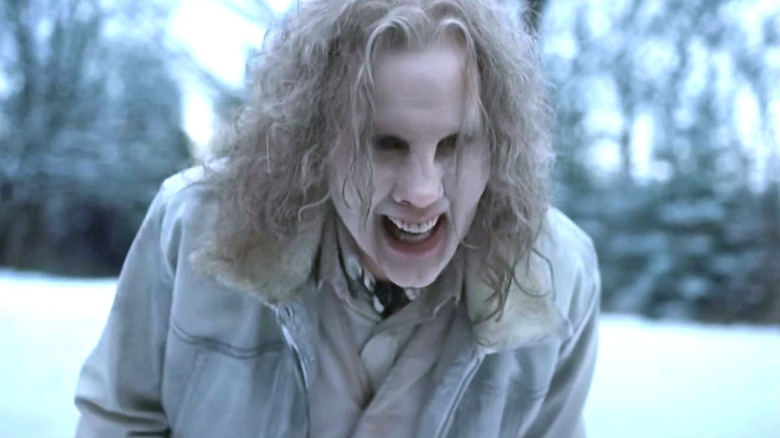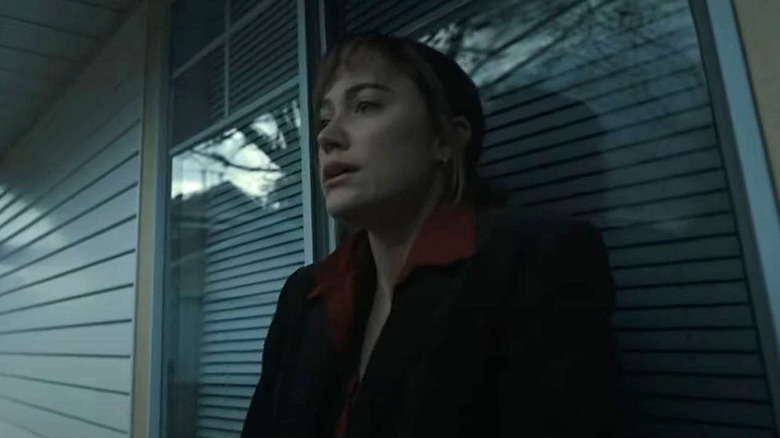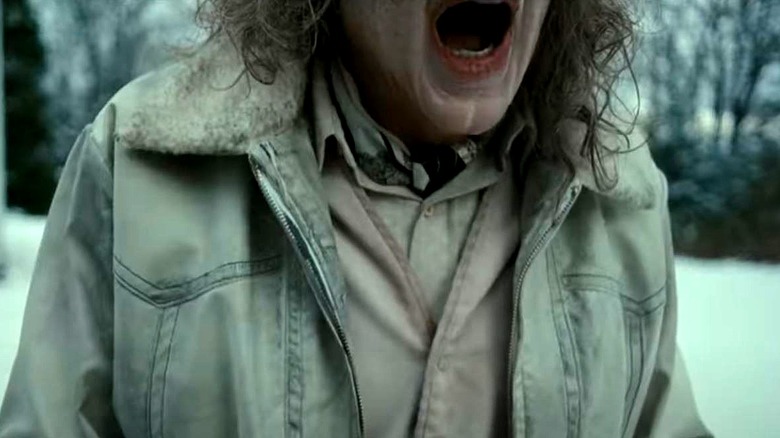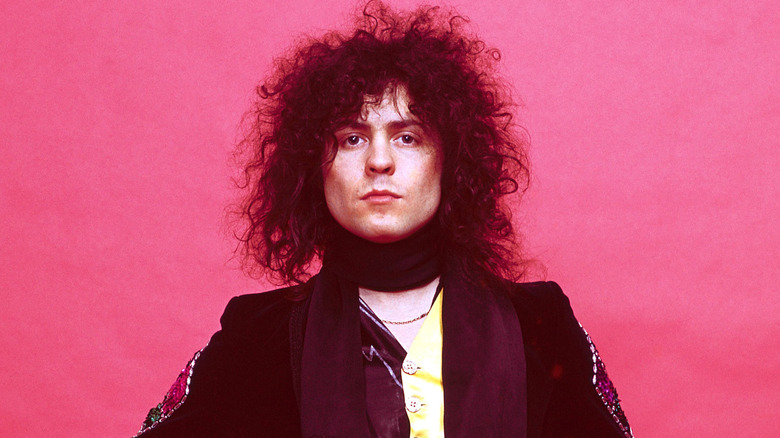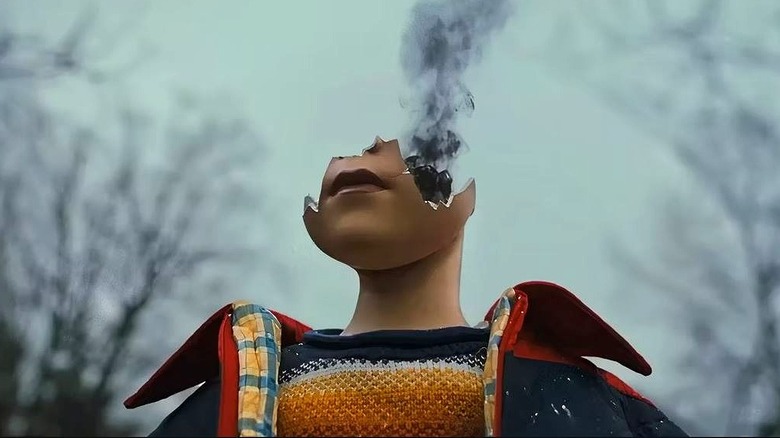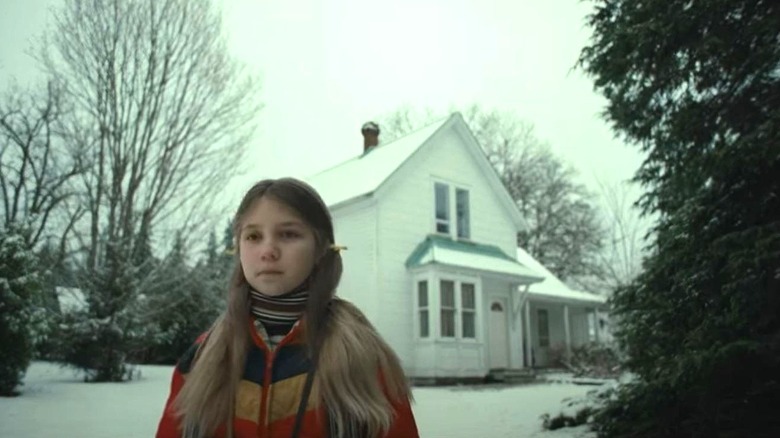Every Part Of The Creepy Longlegs Opening Scene, Explained
The best horror movies of all time haunt you long after the final scene plays. Others, like Oz Perkins' "Longlegs," only need their very first scene to achieve this because the movie's opening is a mystery box that refuses to reveal its contents until the very end of the film. While the real story behind the ending of "Longlegs" may be horrifying since its creepy doll aspects draw heavy inspiration from the murder of JonBenét Ramsey, the majority of its terror comes from the way its big payoff is so thoroughly set up by the film's first scene.
"Longlegs" is one of those movies where every image and sound matters. While the story it tells is twisty and clever, the film's real allure is in the mood it creates and the way it slowly unfolds. The film's opening scene has a lot to do with how the rest of the movie works, and it answers the call by packing every second full of thematic importance and events that will become incredibly important later on. There's plenty here that's easy to miss, so let's unpack every part of the creepy "Longlegs" opening scene. Keep in mind, though, that since the scene plays into every aspect of the movie's plot, there are going to be plenty of spoilers for the entire movie.
What happens at the beginning of Longlegs?
In the interest of full coverage, we'll treat the first scenes of the film's two different time periods as a single long opening scene. After all, one transitions into the other in a seamlessly awkward fashion, and understanding both timelines is crucial in order to understand the movie itself.
"Longlegs" opens in the 1970s as a station wagon approaches a white house in a snowy landscape. A young girl (Lauren Acala) spots the vehicle, grabs a Polaroid camera, and ventures outside, following a strange voice to an even stranger man (Nicolas Cage), whose face isn't entirely visible to the camera. Speaking in a strange, sing-song manner, he congratulates the girl on her approaching birthday and makes an odd comment about wearing his long legs today. The entire sequence is peppered with eerie sound design and liberal jump scare chords, but just as the man starts asking a question and crouches down to provide a closer look at his face, the camera cuts to the 1990s.
Here, FBI agent Lee Harker (Maia Monroe) sits in a briefing about door-to-door searches regarding an unknown, dangerous man. When she and her partner Fisk (Dakota Daulby) start to work on this assignment in a suburban neighborhood, Harker is drawn to a particular house where she claims the suspect is. A disbelieving Fisk agrees to knock on the door to appease Harker, only to be shot in the face by an unseen person. Terrified by the sudden violence, Harker draws her gun and enters the house to chase the culprit. After a gut-wrenching trek through the plastic-wrapped rooms, she finds the apparent killer with his hands raised — sitting on the bed, waiting calmly.
Who was the guy at the beginning of Longlegs?
The strange, softly speaking man in light-colored clothes and stringy hair at the beginning of the film is none other than the movie's titular antagonist, Longlegs, played by a borderline-unrecognizable Nicolas Cage. Adding to the mystery about who plays the character is the way the opening scene keeps his face mostly hidden until the last split second, focusing instead on his strange clothes and the peculiar way he speaks.
Longlegs' real name is Dale Ferdinand Kobble, and he's a devoted devil worshipper who has found a way to kill people without actually touching them himself. Because he has no physical connection to the crimes, the only reason the FBI knows about him in the first place is because he leaves strange letters at the murder scenes. Because "Longlegs" wears its "Silence of the Lambs" influences proudly on its sleeve, the killer also has a close fascination with the protagonist, with whom he shares a surprising connection.
This is just scratching the surface. Even if you forget the whole serial killer aspect of the character, Longlegs is a thoroughly off-putting, somewhat childish guy who behaves strangely and doesn't really know — or care to know — how to interact with people. In other words, with time he'll likely be remembered as one of Nicolas Cage's most bizarre roles. He's a perfect vessel for Cage to chew so much scenery that the villain appears borderline inhuman ... which, of course, works very well. Longlegs is a serial killer in a horror thriller, after all.
What is the quote at the beginning of the Longlegs?
"Well, you're slim and you're weak / You've got the teeth of the hydra upon you / You're dirty, sweet, and you're my girl." These ominous lines that kick off "Longlegs" are far more meaningful than you might suspect. Like "Longlegs" itself, the quote carries heavy rock 'n' roll overtones — not least because it's actually a line from the T. Rex song "Bang a Gong (Get It On)." Oz Perkins used the seminal 1970s band to help the movie set its tone. The filmmaker listened to a whole lot of T. Rex while writing "Longlegs," and, as a result, the titular killer's love for the band and its singer Mark Bolan is both visible and audible in a number of scenes.
In an interview with Rolling Stone, Perkins said that the devil-worshipping villain is effectively a wannabe T. Rex-style 1970s rocker. "It just ended up making sense that I would make [Longlegs] into this glam guy who had sort of had his life disrupted in the Seventies," Perkins said. "He just wanted to be a glam-rock guy. He maybe plays a guitar kind of badly in his mom's basement. And one day, his life changed, and he had to go to work for the Devil."
With this context, choosing lyrics from "Bang a Gong (Get It On)" to open the movie was a natural choice. After all, not only is it one of the best-known T. Rex songs and, therefore, one of Longlegs' favorites, but its lyrics also tie into the hydra theme of a very devilish Bible quote elsewhere in the movie.
What do the dolls mean in Longlegs?
The dolls in "Longlegs" are the titular serial killer's way of murdering people without getting caught. He's learned to create magical puppets that contain a strange, metallic orb. These dolls can make men kill their entire families, and Longlegs uses them to target households where a daughter is about to turn nine on a specific day of the month.
It's left somewhat ambiguous whether the dolls operate by corrupting the killers with Longlegs' personal brand of black magic or if they open the door for demonic possession. Either way, these dolls are the bizarre man's murder weapon of choice, but they also have other abilities, including being able to control and suppress memories. While a doll Longlegs has made for a specific person can technically be destroyed, doing so influences the person as well. At one point in the movie, the destruction of Harker's own doll actually causes her head to emit black mist, after which she passes out.
What is the hidden meaning of Longlegs' opening scene?
The opening scene of "Longlegs" not only introduces the titular antagonist — it also sets up the movie's biggest twist. Toward the end of the movie, we find out there's a reason the villain is visiting the small girl, and also why the scene then immediately cuts to adult Harker. The girl, of course, is none other than Harker herself, who was originally targeted to become one of Longlegs' victims.
Unfortunately, Harker's family had an arguably worse fate than that. Instead of killing her, Longlegs brokered a deal with Harker's mother, Ruth (Alicia Witt). In exchange for Harker's life, Longlegs lived in their basement, and Ruth became his accomplice. The reason Harker doesn't remember this is that Longlegs made her a doll of her own, designed to block out her memories. When the doll is destroyed and Harker recovers, she regains her memories of this era in a rush that shocks her and the viewer alike.
